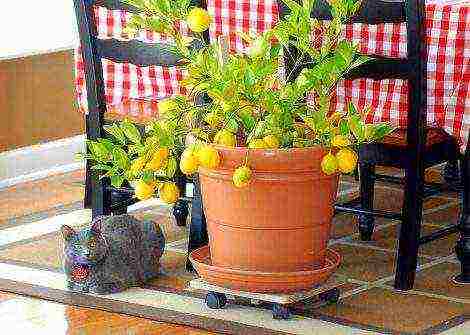Content
- 1 Description of culture
- 2 Characteristics of the fetus
- 3 Lentils in Russia
- 4 Growing features
- 5 The soil
- 6 What fertilizers should be applied?
- 7 Sowing seeds
- 8 Care
- 9 Harvest
- 10 How to germinate lentils?
- 11 Healing properties
- 12 Nutritional value
- 13 Lentil damage
- 14 Diseases and pests
- 15 Useful Tips
- 16 Application
- 17 Advice
- 18 Warnings
Lentils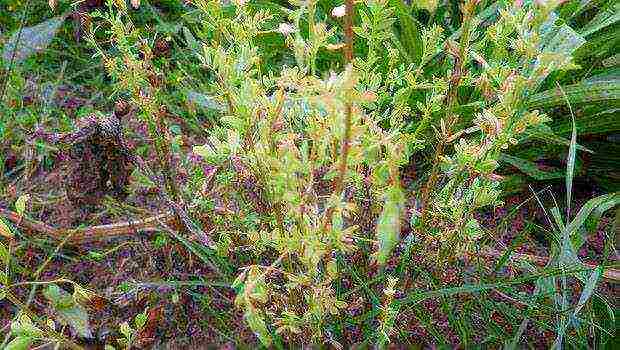
Published by 27.01.2015 |
Lentils are one of the oldest cultivated plants with a high protein content. It can successfully replace bread and, to some extent, meat. Lentil protein is highly digestible and environmentally friendly, since beans do not accumulate nitrates and radionuclides.
Characteristics and properties
Lentils are an annual plant with a slightly branched stem up to 55 cm high.Lentils have compound leaves with several pairs of narrow leaves ending in antennae up to 6 cm long.
Lentils are self-pollinated. The flowers are white, pink or purple up to 8 mm. Pods are bivalve, oval or flat up to 2 cm. Seeds up to 9 mm in diameter.
The vegetation period is 75 - 115 days, seedlings a week after sowing without carrying the cotyledons to the surface.
Beans contain up to 60% starch, up to 35% protein with a good ratio of amino acids important for human life.
The taste of lentil dishes is subtle, more delicate in comparison with other legumes - one of the first places in terms of the taste of legumes.
A decoction of lentils is also useful, it is recommended for kidney stones.
Varieties
Small-seeded lentils, large-seeded (plate) lentils are separated.
Of the large-seeded varieties of lentils, the most common are Tallinn, Petrovskaya, Petrovskaya Jubilee, and New Moon. Variety "Laird" refers to high-yielding and is considered mid-season (75 - 90 days).
The "Stepnaya 244" variety of small-seeded lentils has proven itself well. Variety "Beluga" - the smallest grains of black color, excellent taste, the shape of the seeds is very reminiscent of beluga caviar.
The mid-season "Puy" variety is most appreciated in France for its marble seed pattern, delicate and slightly spicy taste.
Site organization and soil preparation
The best soils for cultivating lentils are considered to be slightly acidic sandy loam or loamy soils, enriched with lime and free from weeds. On heavy soils with high acidity, as well as on alkaline soils, the yield of lentils will be much lower.
The site is selected in a well-lit place, the shade or even weak shade will contribute to forcing the green mass without an adequate return of the bean crop.
Organic matter is not applied under lentils, as this can provoke an active growth of green mass.
When cultivating the soil in autumn or in spring when cultivating a site, it is better to add superphosphate in granular form.
Predecessors
Winter crops, corn and potatoes are considered good precursors for lentils. Lentils will be an excellent precursor for subsequent crops, enriching the soil with nitrogen.
Sowing time
Sow in early or mid-March, depending on the soil temperature at a depth of 4 - 5 cm (optimally about 5 - 6 degrees).
Sowing preparation
Before sowing, the seeds are soaked for a day. If you soak them in a solution of a growth biostimulator, for example, Epin (two drops per 100 ml of water), you can expect a significant increase in lentil productivity (up to 15%), while germination, viability and resistance of sprouts to frost will also increase significantly.
After soaking, the seeds are dried before sowing.
Sowing
During the growth period, lentils are sensitive to the moisture content in the soil, so you should not be late with sowing.It can be sown both in seedlings in humus pots, and in an ordinary way.
With a narrow-row seeding method with a row spacing of up to 15 cm, the seeding rate for large-seeded varieties is 15 g per square meter (250 seeds) or 8 g per square meter (300 seeds) for small-seeded varieties.
Seeds are embedded in the ground to a depth of 5 cm, germinate at temperatures above 4 degrees in a week.
Rolling the beds after sowing lentils promotes the emergence of stronger shoots.
Care
Seedlings can withstand short-term (up to 5 degrees) frosts. The optimum temperature is 17 - 22 degrees.
Lentils develop slowly in the initial period of growth, therefore, the soil after sprouting is harrowed to prevent weeds from clogging the plantings and inhibiting their growth.
As the top layer dries, the soil is moistened.
Top dressing
Top dressing, as a rule, is not done to prevent intensive growth of green mass. An exception may be a very poor soil depleted by predecessors with poor growth and development of lentil seedlings.
Pests
The main pest of lentils is the pea aphid. Also, harm to it can be caused by: lentil weevil, scoop, meadow moth, as well as snails and slugs.
Lentils are susceptible to diseases such as ascochitis and fusarium.
Harvesting
Harvesting in August or September. Since the beans ripen unevenly, harvesting starts from the lower parts of the plant.
When the bottom beans are fully cooked, the lentils can be cut and placed in a swath. The seeds of the top beans will ripen when dried.
Unripe seeds are also eaten. Their taste is distinguished by tenderness and aroma.
Lentil straw is considered a valuable soil fertilizer. Pre-chopped, it can be dug in in the fall for planting cucumbers, potatoes or tomatoes, or used for mulching the soil under bushes in the garden.
Lentils are an amazingly valuable plant from a large family of legumes. She is well known in our country, she is popular abroad. How lentils grow, what are the features of its cultivation, read the article.
Description of culture
Lentils are an annual herb that grows up to sixty centimeters tall. The bush is not large in size. Its stems are tetrahedral and reddish in color. They are erect or lodging, depending on the variety. The stems are covered with hairs of small size and medium hardness along the entire length.

Lentils have complex leaves with a pair-pinned structure. The petiole at the base has a tendril, which is branched or simple. The size and shape of stipules differ in different varieties of lentils. Short stalks have one or more small flowers, shaped like moths. Most often, the petals are white, but they are blue-blue or violet-blue.
The growing season varies depending on the variety, weather conditions and soil. Its duration can be from two and a half months to four. Until the flowering period, which occurs in late May - early June, grows slowly. When the first flowers appear (six weeks after germination), the growth and branching of the bush is accelerated.
Characteristics of the fetus
This is a bean that ripens in one nest with two valves. It is elongated, diamond-shaped and prone to cracking when overripe. There are few fruits, from one to three pieces. They have a rounded or flattened shape and are small in size, up to two centimeters in length.
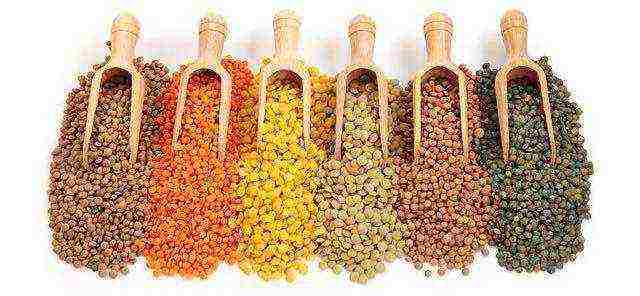
Fruits are yellow, red, green, pink, brown, gray, black, marbled dotted or spotted.
Lentils in Russia
In our country, this culture was known for a long time, five hundred years ago. In those distant times, the cultivation of lentils in Russia was carried out on the Russian Plain. As a grain crop, it was of high value.Where do lentils grow in Russia? In the last century, the place of its growth in our country was the black earth regions of the Volga region and the Urals. Lentils grew in the North Caucasus and Ukraine.

It was called crane peas, cochlea, vichka, lyashta. Lentils were used for baking bread, making porridge and soup. Sausage and sweets were made from it. Currently, lentils in Russia are growing in the Volga region, the Central Black Earth regions of the country, in small areas of Tatarstan, Mordovia, Chuvashia, and the western regions of Siberia.
Growing features
The legume culture will show all its best qualities, subject to the following features of growing lentils:
- For plant growth, fruit formation and a high yield, an important feature should be taken into account. The growing conditions of lentils are such that they need a lot of light for a long time to grow normally. Even ten hours of daylight hours will not satisfy her needs. The plant will be frail, the fruits will not ripen, the yield will decrease.
- Another feature is to provide the plant with moisture and warmth from the beginning of the growing season. Later, lentils calmly withstand drought.
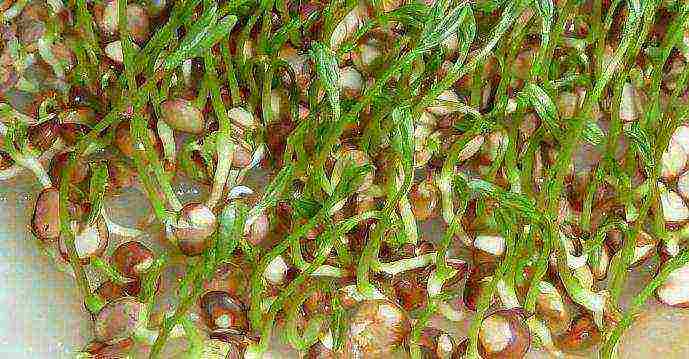
- Seeds are capable of germinating in soil heated to only five to six degrees Celsius. This temperature is considered low.
- Where do lentils grow? The crop cannot be grown on compacted soils with low fertility.
- How do lentils grow? Lentils grow slowly immediately after planting. She very painfully tolerates the presence of weeds in the neighborhood. Therefore, during this period, the beds should be weeded especially carefully.
- On roots accumulate nitrogen, which makes the soil fertile. For this reason, legumes in general, and lentils in particular, are of interest for agriculture.
- The fruits can be eaten unripe, they are even tastier.
The soil
Where do lentils grow? She prefers sandy loam soils or loamy loose soils. In the absence of such a soil environment, heavy soils are used, knowingly counting on a low yield. If the soils are highly acidic, lime should be added to them or plants should be planted in areas previously designated for corn, winter crops or potatoes. Light soils with sufficient moisture are considered ideal. Lentils grow poorly on soils with high acidity and waterloggedness.
What fertilizers should be applied?
Many grow lentils in the country. After choosing a planting site, the soil must be fertilized so that the beans grow well and give a high yield. How do lentils grow? For normal growth in the spring before planting and in the fall during digging, the soil must be fertilized to increase its fertility. Complex fertilizers containing phosphorus and potassium are ideal. Fifty grams is enough per square meter.

Other fertilizers can be applied. How do lentils grow? There will be good growth and a high yield if superphosphate and potassium salt are added in the amount of 20-50 grams and 10-30, respectively, during the digging of the garden in the fall. In spring, the soil is enriched with ammonium nitrate: 10-30 grams per square meter.
Sowing seeds
Planting beans starts early because it is important that the accumulated moisture is preserved in the soil, otherwise the plants will germinate late. In the prepared soil, narrow rows are made, twenty centimeters from one another. Lentil crops are always dense. Seeds are embedded in the soil shallowly, three to five centimeters are enough. They are small in size. Although there are several of them in the pod, the seeds are sown into the ground separately, each at a distance of ten to fifteen centimeters from each other. The deep layers of the soil, at the level of sowing seeds, should warm up to a temperature of three to four degrees Celsius. So that the seedlings are friendly, the seedlings covered with soil are rolled up for closer contact with the ground.
Care
The technology of growing lentils provides for many agrotechnical measures, one of which is care. This legume is an unpretentious plant. How lentils grow, you can clearly see in the photo. She calmly tolerates drought and light frosts. But in the first six months after planting, you need to regularly (daily) water the soil to prevent it from drying out.

Moisture is needed for the growth of the entire plant, but especially for the roots during this period. When they get stronger and gain strength, watering is reduced to two to three times a week. If there are a lot of weeds in the garden, they should be weeded in the aisles and bushes, otherwise they will drown out the lentils and it may die.
Harvest
The beans ripen unevenly: the lower pods ripen earlier than the upper ones. For this reason, they are harvested in two stages: first, when all the beans are ripe, except for those growing in the upper part of the stem, the second is the final harvest when the beans are fully ripe on the entire plant. The fruits are of good quality - they do not crack.
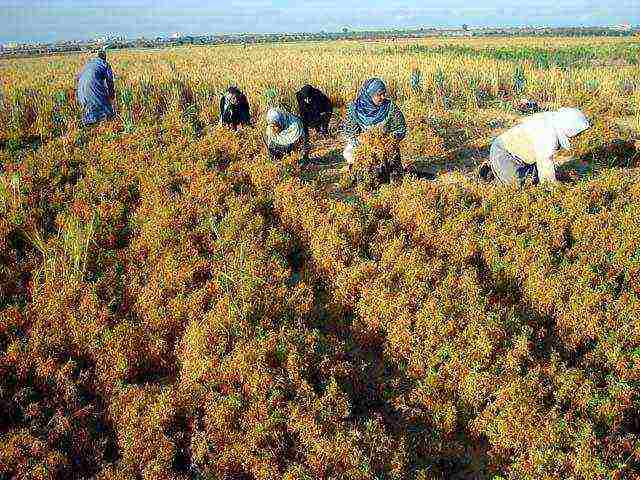
Many field growers mistakenly believe that harvesting can wait. This is a wrong opinion. With late harvesting dates, the fruits retain their appearance, but lose their useful qualities. The green color of the beans indicates the high quality of the lentils, while in overripe fruits it changes to a brown hue.
How to germinate lentils?
This process is straightforward. First, you need to pour over the beans with boiling water. This will stimulate growth. Then fill with water for a period of eight to fourteen hours. After this time, the beans are rinsed and placed on a damp cloth. Top covered with several layers of gauze and placed in a dark place. It should be the warmest in the room. Lentils are washed twice every day. The sprouts will germinate very quickly. When their length is one or two centimeters, you can use it. Sprouted beans should be refrigerated for five days at most.
Healing properties
Lentils have long been used for medicinal purposes. It has the following healing properties:
- Growing up in any conditions, lentils are characterized by the absence of nitrates, radionuclides and other toxic substances, it has the ability not to accumulate them.
- Its fruits help to strengthen the muscles of the heart, normalize the process of hematopoiesis.
- Regular consumption of lentil foods lowers blood sugar. It is recommended to be included in the diet for people with diabetes.
- With stomach ulcers and colitis, the patient is prescribed a special diet, which includes first and second courses based on lentils.
- In its composition, even after processing at high temperatures, important substances are preserved - isoflavones that support women's health. They resist breast cancer cells and prevent the spread of tumors.
- People who consume lentils are less susceptible to cardiovascular disease and hypertension.
Nutritional value
The nutritional and medicinal qualities of lentils have long been appreciated in Europe, from where they spread to the eastern regions, where they are becoming more and more popular. The nutritional value of legumes is as follows:
- Lentils are adapted to the perception of the human body. It is well digested and absorbed. Complex proteins and carbohydrates in lentils saturate the body, the feeling of hunger disappears for a long time, although one hundred grams of the product contains less than three hundred kilocalories.
- Thanks to their high protein content, which is easy to digest, beans replace meat. This is especially important for nutrition in diets. A small portion of beans per day can satisfy a person's need for such a valuable substance as folic acid.
- There is little fat in lentils; there is only one gram of the product per hundred grams. This amount of fat will not increase body weight, but it will provide a feeling of satiety, health and beauty.

- Lentils differ in the content of almost all chemical elements of the periodic table, they contain vitamins of different groups.It is generally accepted that only chocolate contains serotonin. This is not true. Lentils contain the amino acid tryptophan in large quantities. In the body, it is converted into serotonin, which is called the "vitamin of happiness." And rightfully so: the psyche becomes more stable, a person has endurance in stressful situations, depressive states decrease in periods.
Lentil damage
Undoubtedly, beans have many beneficial nutritional and medicinal properties. But they also have disadvantages. It is necessary to refuse dishes from lentils for people suffering from diseases such as gout, uric acid diathesis, dysfunction of blood vessels and heart, diseases of the joints and genitourinary system, overweight.
Diseases and pests
Lentils, like many other plants, are susceptible to pests and diseases. The beans are a breeding ground for the lentil weevil, moths, and meadow moth. The plant has a weak immune system. Suffers from fusarium, ascochitis and rust.
Useful Tips
Anyone who grows vegetables, including lentils, will benefit from any good advice.
- When sowing seeds, you have to move around the garden. Planks can be used to avoid leaving deep marks on the soil. They are placed directly on the ground. They not only protect loose soil, but also trample it down evenly, ensuring close contact with the seeds.
- For better germination, fruits are soaked for two days in a specially prepared solution. A few pebbles of silicon are placed in a glass of water and insisted for about two weeks.
- To clean the harvested beans faster, the pods are dried in the sun, folded in a bag and rolled. The fruits are instantly released from the pods.
Application
Lentils are used in the food industry. Concentrates of mashed potatoes and soups are made from it. Beans are used to cook first courses, cereals, prepare salads, stew them, and use them in combination with mint and other spices. Fruit sprouts rich in folic acid are especially appreciated.
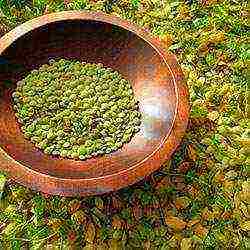 Certain crops are used by gardeners not only for the purpose of harvesting and providing the family with nutritious vegetables, but also for saturating the soil with nitrogen, as well as obtaining looser soil in the garden plot. These crops include lentils. Further, about the features of its cultivation in the open field: planting, care, the best varieties (photo instructions are attached).
Certain crops are used by gardeners not only for the purpose of harvesting and providing the family with nutritious vegetables, but also for saturating the soil with nitrogen, as well as obtaining looser soil in the garden plot. These crops include lentils. Further, about the features of its cultivation in the open field: planting, care, the best varieties (photo instructions are attached).
Lentils: description, features, best varieties and varieties
Lentils are an annual herb, the height of which ranges from 20-70 cm. Lentils, as we all know, are an edible plant. More precisely, its fruits are edible, which can be painted in various colors: black, red, brown. The stem of the plant is thin, densely covered with small, paired, light green leaves. During the active plant period, the lentil resembles a rather small erect / semi-creeping shrub, which during the flowering period has a rather attractive appearance due to the small but lush flowers that completely cover the plant stems.
Attention! Lentils are considered to be an exceptionally environmentally friendly product, as they have an amazing ability to "repel" any nitrates and pollutants. Therefore, even grown in the most ecologically unfavorable regions, lentils are quite suitable for human consumption.
The lentil plant is remarkable for its vitality: it is able to survive both in slight frost and severe drought.
As mentioned earlier, lentils are of several types:
- Brown. Most often it is used for preparing first courses, cereals and snacks.
- Black. Canadian variety. The seeds are quite large in size - about 3 cm. The readiness occurs within 20 minutes after the start of cooking. A well-prepared product has an excellent taste.
- Red (Egyptian). Very fast to prepare. An excellent option for first courses.
- Green.These are unripe brown lentils that are perfect for people with diabetes and gastrointestinal conditions. It will take at least an hour to prepare it, but the result will be worth it.
Among the wide variety of lentil varieties, the following can be highlighted (photo below):
- Puy (French). Lentil beans of this mid-season variety have an unusual marble color and a pungent slightly spicy taste. Lentils do not boil over, completely retain their shape even with prolonged heat treatment, therefore they are perfect for making salads.
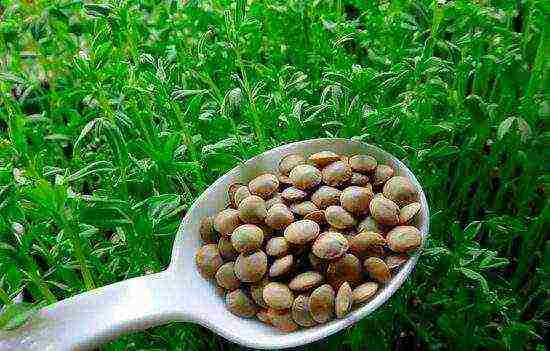
Lentil dishes are popular in different countries
- Laird. Mid-season high-yielding variety. The beans are large enough, round in shape. They have a pleasant rich taste and are suitable for preparing complex dishes that require prolonged heat treatment.
- Anfiya. Mid-season variety, the seeds of which remain green even when fully ripe. The fruits of the plant are distinguished by a rich, very pleasant taste. The variety is incredibly resistant to disease and drought.
- Steppe. The seeds of this variety are distinguished by their rich yellow color and excellent taste.
Landing in open ground
Although lentils are considered an unpretentious plant in terms of growing conditions, the choice of a suitable site should be taken very seriously. The place should be sunny and warm. It is better to give preference to light, loose, neutral soil: the best option would be light sandstone or loam.
Lentils do not tolerate acidic soils very well, so if this is the only thing on your site, be sure to carry out procedures that will help reduce the acidity of the soil: for example, standard liming is suitable.
In spring or autumn (at your discretion), when digging the soil, be sure to apply mineral fertilizers with a predominance of phosphorus and potassium (about 50 g per sq. M.).
Planting a plant in open ground is carried out in early spring, when the soil warms up / thaws sufficiently (15-20 cm deep).
Advice. Before sowing, it is advisable to soak the seed material for 20-24 hours in a nutrient solution - a growth stimulator (thereby, you can increase the germination of seeds by 15-20%).
Dry the seeds thoroughly just before sowing. Prepare small furrows about 5 cm deep in the soil. Place the prepared seeds there. Gently sprinkle them with a small layer of soil and lightly tamp it.
Full sprouts should appear in 10-14 days. Be sure to thin them out to prevent the possibility of weeds on the site. Please note that in the first 30-40 days, lentils grow extremely slowly, so if the sprouts are not gaining strength and growth very quickly, do not rush to abandon the plant: after the beginning of flowering, it will grow rapidly.
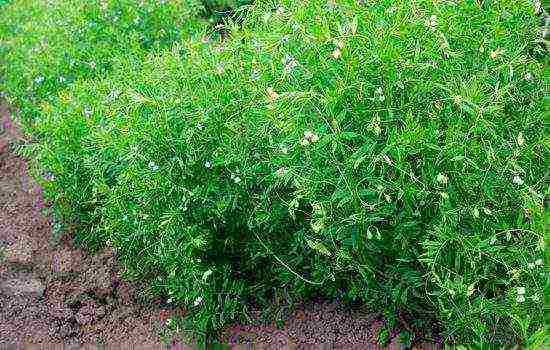
Lentil bushes
Plant propagation
The process of reproduction of lentils is carried out mainly by seeds. Since they are quite large in size, there is no particular need to prepare the soil before planting a crop. Sowing seeds can be carried out in the ground by mid-spring, when the snow has completely melted. For lentils to germinate well, the air temperature must be consistently above +5 degrees.
In especially harsh climates, lentils are grown exclusively for seedlings. Sowing of seeds is carried out in separate containers a month before planting on the site. Immediately before planting already strengthened shoots, they should be hardened. Landing in the ground is carried out approximately at the end of May.
Plant care rules
Lentils are a unique plant, the care of which is not only simple, but also pleasant, so even a novice gardener will be able to cope with the task of growing lentils.
Lentils do not really need watering, because, as mentioned earlier, they are not at all afraid of drought. Nevertheless, in the first 1.5 months, it is better to fully provide the plant with water so that it can gain strength as quickly as possible and grow.
After the lentils have bloomed, the frequency of watering can be reduced to 2-3 times a week. In addition, if weeds are quite common on your site, you should regularly thin out the growing lentil bushes and loosen the soil on the site.
As for dressings, the best for lentils is phosphorus-potassium. As already mentioned, it is best to introduce them before starting the cultivation of the plant: either in the fall when digging, or in the spring before the start of sowing work. It is better to refuse the use of organic matter altogether, since in this case all the power of the plant will go to the formation of a lush green mass, and not fruits.
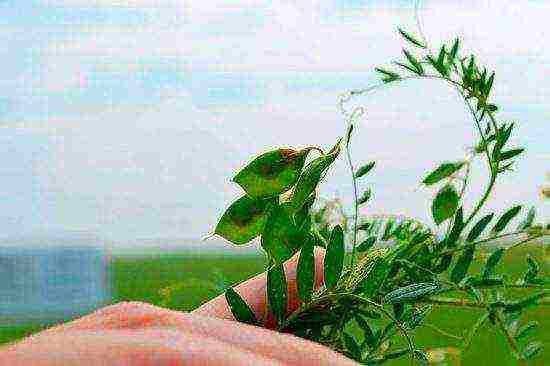
Garden neighbors are very important for lentils.
Disease and pest control
Unfortunately, lentils are sometimes attacked by pests and, in some cases, can get sick. The following are the main lentil pests and diseases:
- Caryopsis. The parasite is a small black beetle about 4-6 mm long. It can be easily distinguished from other bugs by its small brown / gray stripes near the wings. Caryopses usually overwinter in damaged lentil fruits, and eggs are laid in young beans.
- Meadow moth. It is very dangerous during breeding periods, which happens every 10-12 years. Able to hit from 50 to 100% of the crop.
- Gamma scoops. They feed exclusively on green lentils. They hibernate in the ground. Method of struggle: perfectly helps in the fight against scoops by weeding the row spacings of the plant, as well as sowing flax.
- Ascochitis. Fungal disease, the appearance of which is indicated by dark spots of various sizes on the lentil foliage. Dark, slightly raised spots also appear on the beans. The fungus can develop during periods of moisture or rain. It is very easy to prevent the disease: you just need to thoroughly ventilate the seeds before sowing and sow them in a timely manner.
Combination with other plants
When planting a plant, it is extremely important to take into account its predecessors, as well as "neighbors" in the area, because not every crop has a good combination of lentils. In no case should you cultivate lentils in those places where crops belonging to the same family grew before: peas, beans, lentils, chickpeas, etc. But the good development of lentils can be observed on the ground, where its predecessors were tomato , potatoes, as well as cucumbers, cabbage, pumpkin.
That's all the subtleties you need to know to successfully grow lentils outdoors in your area. Good luck!
Lentil cultivation: video
3 parts: Choosing a site for planting Planting lentils Plant care
Lentils are a wonderful crop that is very rich in protein. Luckily for those looking to grow them, planting and caring for lentils is easy. Start with quality seeds or dry lentils. Plant them in a pot or choose a spot in your garden with plenty of sunlight and plenty of water. As a rule, after a hundred days you will be able to harvest.
Part 1 Choosing a Landing Site
-
 Take seeds or dry lentils.
Take seeds or dry lentils.
Lentil seed packets are not always available at a gardening store. You may need to buy seeds hand-held or from a dedicated online store. However, ordinary dry lentils, which can be bought at any supermarket, are also suitable for planting.
- Lentil kernels must be whole or they will not sprout.
-
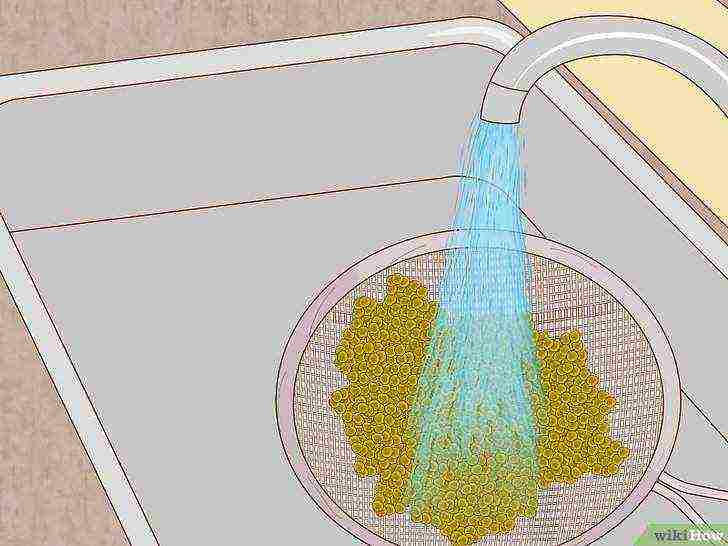 Rinse and sort out the seeds.
Rinse and sort out the seeds.
Empty the seeds into a colander and rinse with a little water. Then select and discard seeds that are cracked, cracked, or discolored.
-
 Plant lentils in the spring.
Plant lentils in the spring.
Lentils develop well in fairly cool weather, and they ripen best in summer, when warm. In order for the seeds to survive and germinate, the soil temperature during planting must be at least 4 ° C. Don't worry if frost occurs after planting: most sprouts will survive, even if they have to regenerate from the roots.
- If the climatic conditions in your area do not allow you to plant lentils directly in the ground, you can plant them at home. In this case, the air temperature in the room must be at least 20 ° C. If your house (or apartment) is cold, you can install a special lamp next to the seedlings to maintain the desired temperature.
-
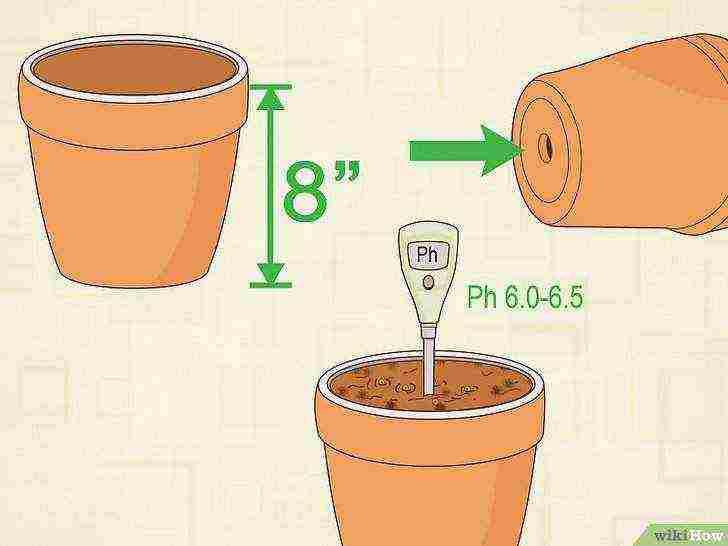 Choose a sunny location with adequate water supply.
Choose a sunny location with adequate water supply.
Lentils grow well both in the garden and in a pot at home. The most important thing is to provide the plant with plenty of sunlight. It is best to plant lentils next to short plants so that they do not obscure the light. The soil should be moist enough, but make sure that the water does not stagnate in the upper layers of the soil, otherwise the lentil roots will rot.
- If you decide to plant your lentils in a pot, choose a pot that is at least 20 cm deep so that the roots of the plants can fully develop.
- If you feel that the soil in your garden is too acidic or, conversely, alkaline, use a soil acidity tester, which you can buy at a gardening store. A soil with a pH of 6.0 to 6.5 is best suited for growing lentils.
Part 2 Planting lentils
-
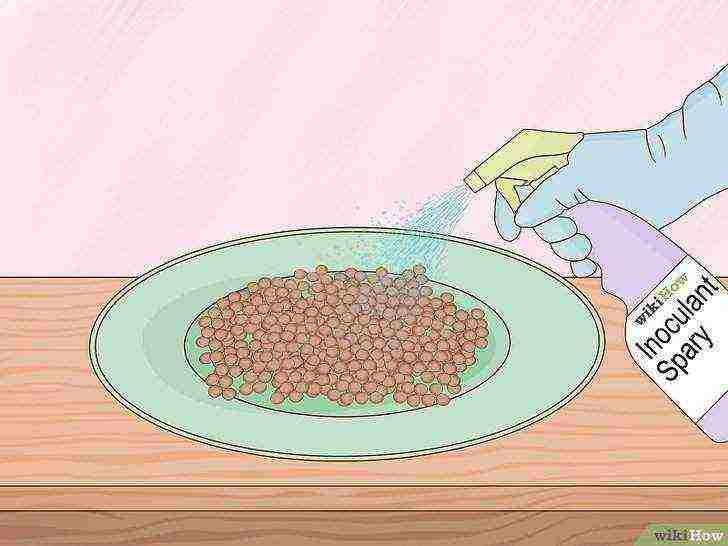 Treat the seeds with an inoculant.
Treat the seeds with an inoculant.
Sprinkle or spray a mixture of beneficial bacteria called an inoculant before planting lentil seeds. It can be purchased at a gardening store. For lentils, a regular legume inoculant is suitable. Thanks to this pre-treatment, additional nodules, or shoots, will appear on the roots of the lentils, which will make your plants more resistant to changes in weather conditions and increase the yield.
-
 Plant the seeds at least 1 inch (2.5 cm) deep.
Plant the seeds at least 1 inch (2.5 cm) deep.
If the soil you choose to plant is moist and in good condition, plant the seeds at a depth of 2.5 cm. If the topsoil is relatively dry, plant the seeds at a depth of 6.5 cm, but no more. If you plant seeds too deep, they will not germinate.
-
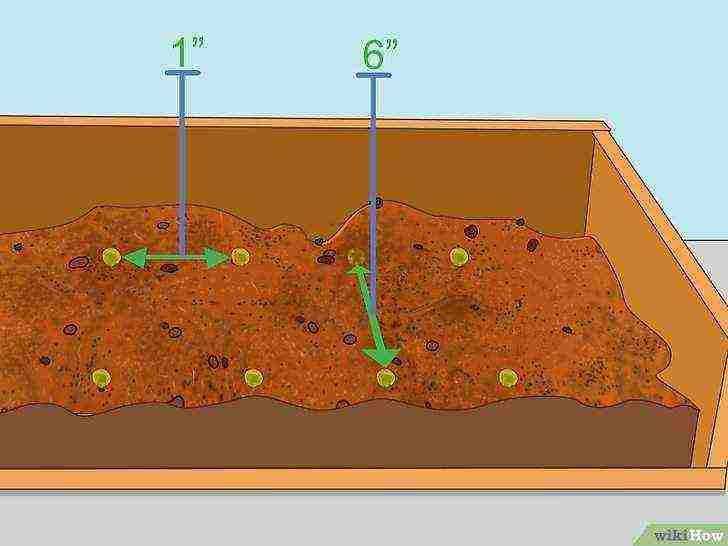 Plant the seeds at a specific distance from each other.
Plant the seeds at a specific distance from each other.
If you are planting lentils in a pot, the distance between the seeds should be at least 2.5 cm. This distance should also be adhered to if you are planting lentils in your vegetable garden. In this case, the distance between the beds should be about 15 cm. Thus, from 30 m2 it will be possible to collect about half a kilogram of lentils.
Part 3 Plant care
-
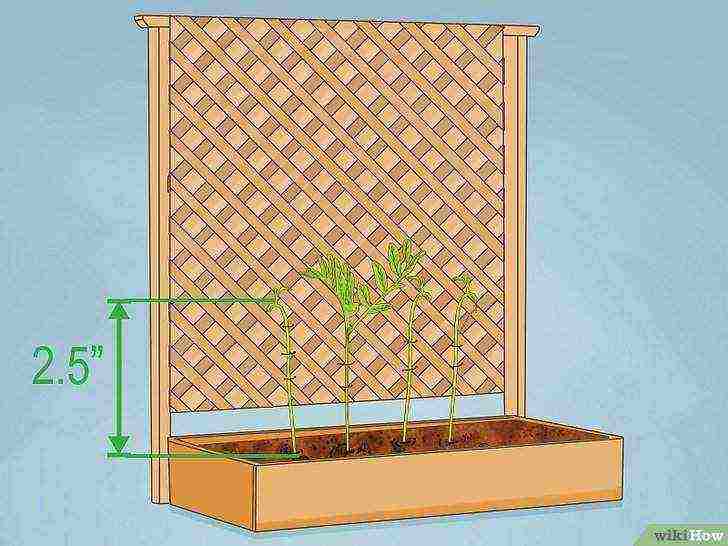 Provide props for mature plants.
Provide props for mature plants.
Mature lentil plants can grow to a height of 75 cm. If they lean down, their flowers or pods can break off or sink to the ground. Use low supports or trellises to support the plant. You can also use small wooden pegs with strips of cotton to protect the lentils.
- You can easily make props if you take a few wooden pegs about a centimeter in diameter and place them next to the lentil plants. Attach the stems to the pegs with cotton strips. Then secure the structure by tying the plants together with a nylon or cotton cord.
-
 Water your lentils twice a week.
Water your lentils twice a week.
Like other heat-loving plants, lentils tolerate drought quite well. However, it will grow best if you water it so that the soil becomes moist. Check the moisture content of the soil by pressing on it with your finger. It should be damp, but no water should appear at the pressure point.
-
 Weed and thin out crops regularly.
Weed and thin out crops regularly.
Weeds can quickly choke lentils or interfere with their growth. To avoid this, set aside time to weed the beds once a week. Remove all weeds thoroughly. If lentil plants are growing too often, blocking the light and interfering with each other's development, remove the excess plants. One healthy plant is better than several weak and poorly fruiting ones.
- This also allows more air to flow into the soil.This will reduce the likelihood of fungal and other diseases in plants that can develop in stagnant soils.
-
 Destroy pests.
Destroy pests.
Aphids, tiny pear-shaped insects that feed on plant sap, can make your lentils a favorite. If you see aphids on the plants, take a spray bottle or garden hose and spray the insects with water until they fall to the ground. If you find weevils on your lentils, pluck up the damaged plants and discard them as soon as possible.
- If cows or other herbivores eat your lentils, place a fence around the plants or cover them with a fine netting.
-
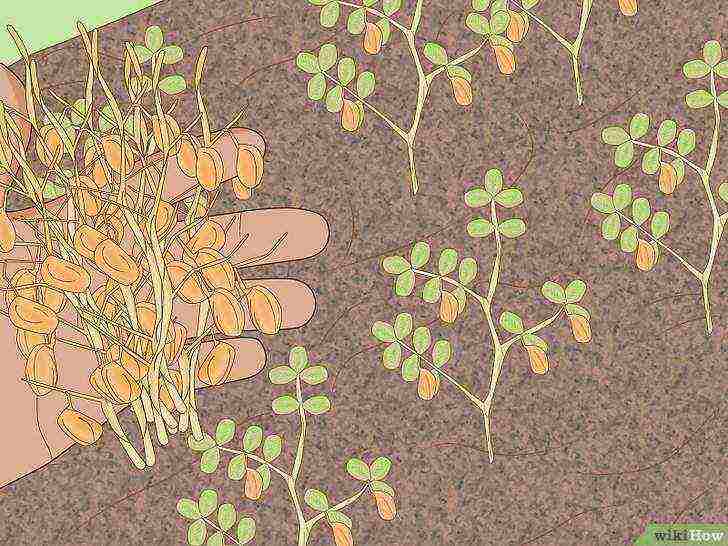 The crop will ripen in 80-100 days after planting.
The crop will ripen in 80-100 days after planting.
When the bottom third of the pods begin to tap when shaking or turn a yellowish brown color, cut the plants at soil level. Then break open the pods and remove the seeds from them. Let them air dry and then rinse with water.
- Store harvested lentils in an airtight container
Advice
- Lentils can be used to make a variety of dishes, including many soups and salads. It can also be used to fertilize the soil by grinding the seeds and mixing them into the soil before planting the plants.
Warnings
- Lentils grow best when planted next to cucumbers or thyme (thyme). It should not be planted next to pungent-smelling plants such as onions or garlic, as this can affect the taste of the lentils.
Article Information
Categories: Gardens and vegetable gardens
In other languages:
English: Grow Lentils, Tiếng Việt: Trồng đậu lăng, Français: faire pousser des lentilles, Deutsch: Linsen anpflanzen, Nederlands: Linzen kweken, العربية: زراعة العدس, Italiano, Coltivare le 文文:::扁豆, Español: sembrar lentejas, Português: Cultivar Lentilha, Bahasa Indonesia: Menanam Lentil
- Edit
- Write a letter of thanks to the authors
This page has been viewed 534 times.
Was this helpful?


